Table of contents
Dried or dehydrated bananas ( Musa × paradisiaca ) are very popular as a snack. They are available in stores as hard banana chips (crunchy) as well as softer, dried banana pieces. If the dried bananas have a brownish color, no sulfur has been added.
Use in the kitchen:
Due to the removal of water, the nutritional and energy density is concentrated in the dried bananas. Dehydrated bananas have an even lower water content. The taste of dried bananas is usually more intense and sweeter than that of fresh bananas .
You can simply nibble on dried bananas as a healthy snack between meals or use them in a variety of ways when cooking and baking. They are ideal as an ingredient in tasty smoothies, chutneys, fruit salads, muesli ( pea muesli ) and desserts . However, you should still choose fresh bananas if possible.
When we talk about banana chips, we usually mean sliced, fried in oil and dried (sometimes unripe) bananas. Preservatives and sweeteners are often added. 1 These are often a component of trail mix.
The banana chips (upperi) known in India are roasted in coconut oil and coated with masala (Indian spice mixture) or jaggery (unrefined cane sugar ). Some banana chips are also made from plantains , the starchier bananas.
Vegan Banana Chip Cookies Recipe:
Ingredients: 350 g banana chips (or dried bananas), 500 g flour , 250 g liquid honey , 1 tsp cocoa powder , 1 tsp ground cinnamon , 1 tsp baking powder , water if needed.
Preparation: Preheat the oven to around 180°C. Chop the banana chips (to do this, put them in a bag and use a wooden mallet to beat them into small pieces). Then add the flour, baking powder, cocoa powder and cinnamon to the chopped banana chips. If the honey is not liquid, you can warm it up a little. Mix the liquid honey with the flour mixture and knead into a dough by hand. If necessary, add a dash of water. It is important that the dough does not stick, otherwise you will have to add a little more flour. Now form small balls with your hands and flatten them on the baking tray lined with baking paper. Bake the cookies in the hot oven for 10-12 minutes, remove and allow to cool.
| Not only vegans or vegetarians should read this: Vegans often eat unhealthily. Avoidable nutritional mistakes . |
Shopping - where to buy?
Of the following supermarket chains - Coop , Migros , Denner , Volg , Spar , Aldi , Lidl , Rewe , Edeka , Hofer etc. - only selected stores offer dried bananas. Most often you will find banana chips that are fried in coconut oil, less often whole dried bananas. Industrially dried bananas are often treated with sulphur dioxide or granulated sugar is added to them. Sulfur is used so that the bananas retain their light, yellowish colour and have a longer shelf life. The added sugar is unnecessary because dried bananas naturally contain a lot of fructose and therefore taste sweet.
Sometimes freeze-dried banana pieces or chips made from bananas are available that are not enriched with sulphur, oil or sugar. However, they still retain their colour when processed in this way. On the other hand, the term "dried bananas" always means that they are air-dried bananas.
Prefer natural, i.e. naturally produced, unfried, unsweetened and unsulfured dried bananas. You can find these in health food stores, organic shops or in online shops.
When buying dried bananas, you should also look for controlled organic quality, as this guarantees fewer pollutants. Organic dried fruits must not contain any preservatives such as sulphur, methyl bromide, sorbic acid etc., but conventional ones do. 2
Homemade preparation:
How can I dry bananas? Dried or dehydrated bananas are very easy to make yourself. All you need is a knife, baking paper, an oven or a dehydrator and fresh bananas. These should be ripe, but not overripe. Bananas can also be dried in the sun, especially in subtropical areas, but they should be protected from vinegar flies.
First, peel the banana, cut it into slices that are as thin as possible and place them on a baking tray lined with baking paper. Alternatively, you can dry them by cutting them lengthways. Tip: If you soak the banana slices in lemon juice for a short time or sprinkle them with lemon juice, they will turn less brown later.
The maximum temperature for drying bananas should be around 40 °C. At higher drying temperatures, valuable vitamins are lost. During drying in the oven, the door should be slightly open so that the moisture can escape easily. The drying times depend on the temperature, the thickness of the banana slices and the desired degree of dryness. For thinly sliced bananas, the process takes 6-12 hours with good air circulation, and for halved bananas, one to two days. If the water content is < 15%, the probability of fungal attack is very low. The shelf life also increases significantly.
Sun-dried bananas are only found in tropical areas where temperatures are constant.
Storage:
How long do dried bananas last? Dried bananas can be stored for a very long time in a closed container in a dry, cool and dark place. If dried well, dried or dehydrated bananas can even be kept for many years and still taste good.
Ingredients - nutritional value - calories:
Dried bananas contain 301 kcal per 100 g. The carbohydrate content is 71%, sugar makes up about 56% and fiber 6.4%. Proteins are rather sparse at 3.7% and fat is almost non-existent at 0.58%. 3
Due to the low water content in dried bananas, the nutrient content is significantly more concentrated than in the fresh product.
Pyridoxine (vitamin B 6 ) is present in good quantities in dried bananas at 0.93 mg. Dried herbs such as parsley or oregano have equivalent amounts. Dried shiitake also has 0.93 mg/100g. This water-soluble vitamin is important for enzymatic reactions and protein metabolism. 3
Our body needs the macro element potassium to maintain the osmotic pressure in the cells. Dried bananas contain 1,183 mg/100g of potassium. The content is very similar to that of the dried herbs mentioned above. Legumes such as white beans also have a high potassium content (1,795 mg/100g). 3
Dried bananas have about 0.83 mg of manganese per 100 g. Dried mushrooms (e.g. porcini mushrooms ) have comparable values (0.8 mg). This trace element is important for the development of cartilage and connective tissue. Wheat germ contains larger amounts at 13 mg/100g. 3
The vitamin C content (28 mg) in dried bananas is also noteworthy. However, dried herbs sometimes have a much higher value: e.g. rosemary 61 mg, wild garlic 178 mg and coriander leaves even 566 mg/100g. 3
More information about the ingredients can be found in the tables at the bottom after the text.
Health aspects - effects:
In small quantities, sweet, dried bananas are ideal energy bombs. Dried bananas are also an excellent snack for sporty people or those who exercise a lot every day or do physical work.
The high potassium content of bananas can have a positive effect on the heart and circulation. Thanks to the fiber, natural starches and polysaccharides in the pulp, eating bananas can regulate bowel movements. However, dried fruit should never replace fresh fruit, but only complement it.
Dangers - Intolerances - Side effects:
Dried bananas have a significantly higher fructose and therefore energy content than fresh bananas. If consumed in large quantities, this can lead to flatulence or diarrhea, especially with banana chips, as these are often processed unripe. This means significantly more indigestible starch. Only enjoy dried bananas and other dried fruits in small quantities and prefer fresh fruit.
Sulphurized dried fruits can cause reactions in people with allergies, sensitive people or people who lack the enzyme sulfite oxidase. Sometimes severe intolerance reactions are possible, such as asthmatic reactions when eating foods containing sulfur dioxide or sulfite. 4
Most people with fructose intolerance have a relatively poor tolerance for dried or dehydrated bananas. Fresh bananas, on the other hand, are often better tolerated. 5
Occurrence - Origin:
The banana (genus Musa ) originally comes from the Southeast Asian islands. 6 It is mentioned in Buddhist and Indian writings around 600 BC. The banana probably came to Africa with immigrants who settled in Madagascar from what is now Indonesia. Spaniards cultivated the banana on the Canary Islands around 1400. From there the banana came to America and Portuguese settlers founded the first plantations in the Caribbean and Central America.
Cultivation - Harvest:
Bananas are herbaceous perennials and, depending on the species, can even reach tree height ( Musa ingens grows up to 15 m tall). 7 They are usually propagated vegetatively via underground rhizomes. 8 Since cultivated bananas are grown without fertilization of the female flowers, i.e. by parthenogenesis (virgin birth), most banana varieties are clones. New varieties can only be created through mutations or targeted mutation breeding. Important breeding reasons are susceptibility to nematodes, viruses and fungal diseases, which cause problems especially on large plantations. One of the most important varieties at present is called "Cavendish".
Bananas are mainly grown in monocultures for export, which requires a very high level of pesticide use. Bananas also require a lot of water. The plants usually only grow for two years on plantations and only bear fruit once. They can be grown in direct sunlight as well as in shade or semi-shade conditions. 9
In organic banana cultivation, disease and pest infestation are prevented by means of mixed crops and wide planting distances. In addition, attempts are made to maintain healthy soil fertility by adding enough organic material to the soil through mulching. These health measures are also noticeable in the taste and quality of the organic bananas. They have a much firmer, yellower and more aromatic flesh and can be kept for longer even without irradiation. 2
The harvest for export takes place when the bananas are green and ripe. In the packing house, conventional goods are disinfected with sodium bisulfite or sodium hypochlorite. During shipping, the temperature is reduced to 14-15 °C. After arrival, the temperature is increased and the goods are brought to yellow ripeness using 0.1% ethylene. 8
Animal protection - species protection - animal welfare:
Pesticides are used in large quantities on conventional banana plantations. These are sprayed over the plantations by plane, where they not only damage the health of the farm workers, but also pollute the local groundwater. The exposed soil in particular allows the poisoned surface water to seep into the groundwater.
Plantation cultivation also causes massive erosion damage, as the forests had to make way for bananas. For large corporations, bananas are mainly planted in monocultures, while small farmers usually prefer mixed crops. 7
General information:
There are around 50-60 species within the Musa genus of banana plants (Musaceae). Linnaeus described the original species as Musa sapientum or Musa paradisiaca , but according to Brücher these are based on seed-sterile hybrids. There is therefore no botanically correct description of a "type" of cultivated bananas. There are diploid, triploid and tetraploid biotypes of bananas, many of which are mutants and clones. 7 Rehm and Espig , on the other hand, support the name Musa x paradisica. 8
Alternative names:
The sweet banana we know is also called dessert banana or fruit banana, and can also be found classified as Musa x paradisiaca on Wikipedia . An outdated name is paradise fig. 10
Other uses:
The related plantains are only suitable for raw consumption when fully ripe. Unripe plantains are often cooked, baked or grilled before consumption. Banana blossoms (banana hearts) are known as a fruit in Southeast Asia. The leaves of the banana plants are used as serving leaves or as a flavorful baking and grilling cover. 10
Literature - Sources:
Bibliography - 10 Sources
| 1. | Wikipedia Bananenchips. |
| 2. | Pini U. Das Bio-Food Handbuch. Ullmann: Hamburg, Potsdam. 2014. |
| 3. | USDA United States Department of Agriculture. |
| 4. | Bayerisches Landesamt für Gesundheit und Lebensmittelsicherheit. Autor: Krause R. Schwefeldioxid. 2012. |
| 5. | Fructoseintolerances.org Fructose-Nahrungstabellen. |
| 6. | AJ Lentfer, RC Green. Phytoliths and the Evidence for Banana Cultivation at the Lapita Reber-Rakival Site on Watom Island, Papua New Guinea. Records of the Australian Museum. 2004;29. |
| 7. | Brücher H. Tropische Nutzpflanzen: Ursprung, Evolution und Domestikation. Berlin: Springer-Verlag. 1977. |
| 8. | Rehm S. Espig G. Die Kulturpflanzen der Tropen und Subtropen. Anbau, wirtschaftliche Bedeutung, Verwertung. Eugen Ulmer: Stuttgart. 1976. |
| 9. | Wikipedia Dessertbananen. |
| 10. | Wikipedia Bananen. |

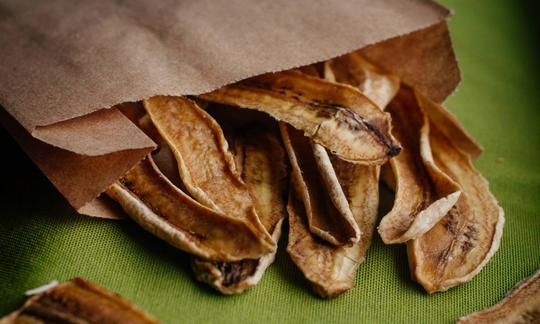

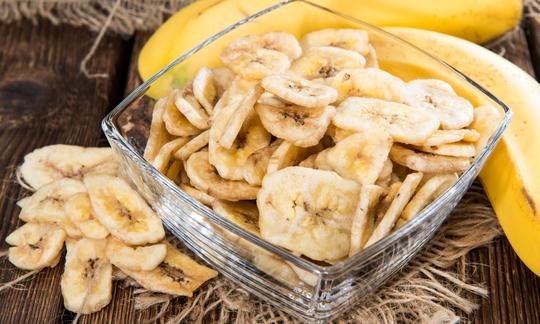

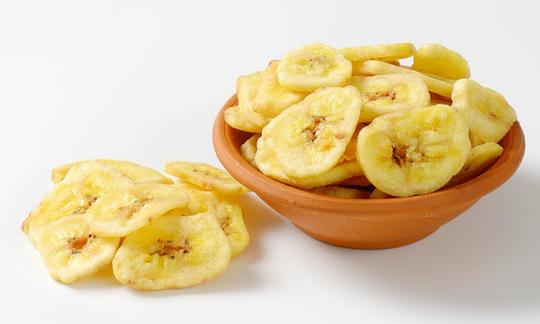

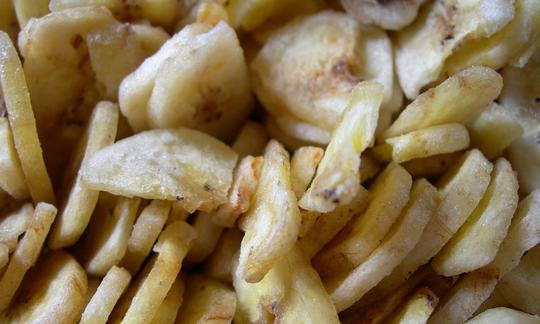

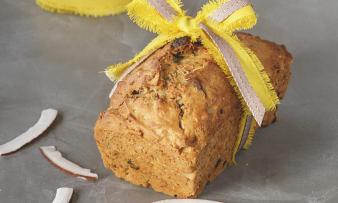





Comments